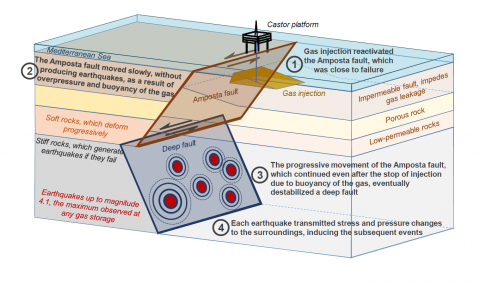
Vilarrasa, V., De Simone, S., Carrera, J. and Villaseñor, A., 2021. Unravelling the causes of the seismicity induced by underground gas storage at Castor, Spain. Geophysical Research Letters, 48, e2020GL092038. Link
Summary
Underground fluid injection for energy-related activities usually induces microseismicity (not felt earthquakes). But felt earthquakes are sometimes induced, which may cause public concern and project cancellation. This was the case of the offshore Castor underground gas storage (UGS), Spain. Gas injection induced numerous seismic events, including three with magnitudes around 4, larger than any other earthquake ever induced by UGS. These earthquakes occurred after the stop of injection in the crystalline basement, which is hydraulically disconnected from, and significantly deeper than the storage formation. To explain this seismicity, we propose a combination of mechanisms. First, the Amposta fault, bounding the site, crept (failed slowly, aseismically) because of pore pressure buildup induced by injection, which reduces the effective compression stabilizing faults, and stress variations caused by gas buoyancy. Aseismic slip of the Amposta fault provoked underground displacements, which reactivated a critically stressed unmapped fault in the crystalline basement. We attribute the delay between earthquakes of the sequence to rock expansion, and stabilizing pore pressure drop, in areas where slip displacement might cause new earthquakes. Earthquakes occur only after the pressure drop dissipates, which takes some time. Assessing fault stability prior to gas injection would have identified the risk of inducing seismicity.

